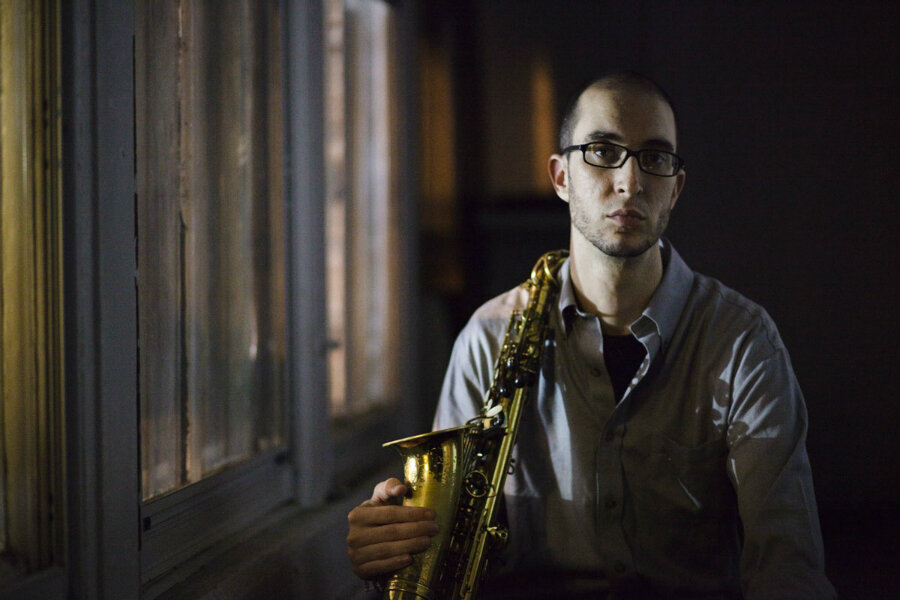Looking Forward and Back: Steve Lehman Speaks
 Steve Lehman has built a career not only through his muscular tone on saxophone, but also formidable intellect. “He’s a state-of-the-art musical thinker,” raved the New York Times two years ago. His forays into spectral harmony and liminality have taken him across disciplines and into collaborations with Anthony Braxton, the Talea Ensemble, and Vijay Iyer. This weekend, he’ll resurrect his Quintet, which last released an album, “On Meaning,” in 2007. This iteration will feature Jonathan Finlayson on trumpet, Chris Dingman on vibraphone, Matt Brewer on bass, and Justin Brown on drums. We caught up with Lehman by phone; excerpts are below. The Jazz Gallery: What’s the occasion for this concert?
Steve Lehman has built a career not only through his muscular tone on saxophone, but also formidable intellect. “He’s a state-of-the-art musical thinker,” raved the New York Times two years ago. His forays into spectral harmony and liminality have taken him across disciplines and into collaborations with Anthony Braxton, the Talea Ensemble, and Vijay Iyer. This weekend, he’ll resurrect his Quintet, which last released an album, “On Meaning,” in 2007. This iteration will feature Jonathan Finlayson on trumpet, Chris Dingman on vibraphone, Matt Brewer on bass, and Justin Brown on drums. We caught up with Lehman by phone; excerpts are below. The Jazz Gallery: What’s the occasion for this concert?
Steve Lehman: Really, the occasion is getting together without an occasion. Especially when I perform in New York, it’s so often oriented toward getting ready to make an album, or a tour: having to frame it as a big event. I wanted to give myself the space to be serious about the music, but also create a platform to play with people I haven’t played with in a while. And to feel like it’s okay to do a concert without thinking about what the press release is gonna be.
TJG: What will the material be?
SL: There might be some new arrangements. We brought in a René McClean piece. We’re doing a Kenny Kirkland piece called “Chance” that I’ve done with the trio a fair amount. But I’m not premiering any new music.
TJG: Have you played with any musicians recently that have had a profound impact on your playing?
SL: I’ve had pretty long standing relationships at this point. I don’t shake the personnel up. At the same time, I love getting to play with new people. This will be the first time I get to play my music with Justin Brown. We’ve played in a couple other contexts. That’s always great to connect with someone whose music you feel an affinity for.I have been working on a project that has a recording coming out later this year, called Selebeyone. That was the first time I worked with any kind of vocal component. It was two rappers: one from Senegal [Gaston Bamar Ndoye], and one from the states [HPrizm], who’s also a longtime collaborator of mine. The way we integrated electronic and acoustic elements, I certainly learned a lot from it.
TJG: Has it been any different working with hip-hop artists?
SL: Labels aren’t that important. I’m focused on the nuts and bolts of the music: what’s going on with rhythm, harmony, melody, timbre. That’s usually what draws me to somebody’s music rather than the genre distinctions.
TJG: You’ve taught at many colleges, including Wesleyan, The New School, and Columbia, and studied under Anthony Braxton at Wesleyan. What is the state of jazz on campuses today?
SL: I’m starting to see more and more of a radical and meaningful integration of black music, improvised music, jazz, into the overall curriculum in music departments across the country. That would be in contrast to a model where any kind of jazz offerings function as an isolated path. I think Vijay Iyer is a big part of that, as well George Lewis at Columbia. I’m hoping to follow in their footsteps myself. I’m hoping that trend of a real integration of ideas and aesthetics of those musics keeps going.
The Steve Lehman Quintet plays The Jazz Gallery on Friday, March 4th, and Saturday, March 5th, 2016. The group features Mr. Lehman on alto saxophone, Jonathan Finlayson on trumpet, Chris Dingman on vibraphone, Matt Brewer on bass, and Justin Brown on drums. Sets are at 7:30 and 9:30 P.M. each night. $22 general admission ($12 for members), $27 for reserved cabaret seating ($17 for members). Purchase tickets here.
